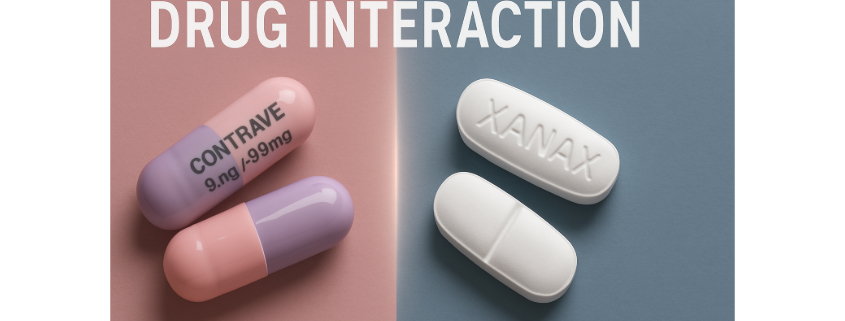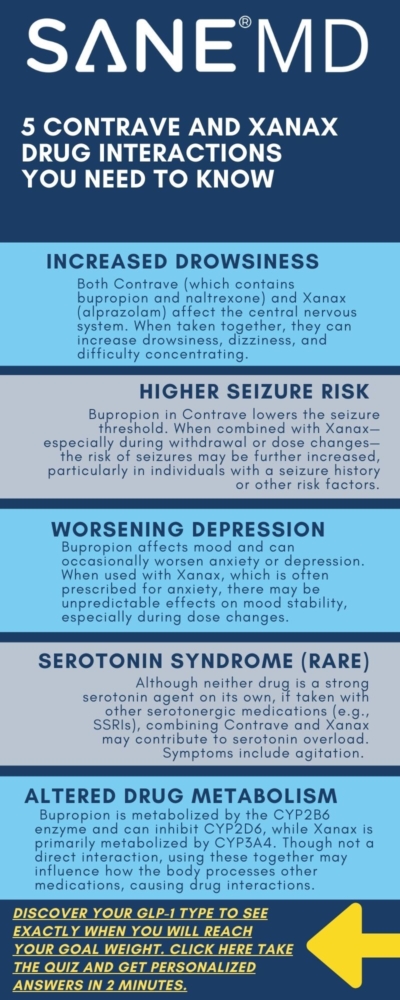Contrave and Xanax Drug Interactions: What You Need to Know
Dr. Matthew Olesiak, MD, is the Chief Medical Director at SANESolution, a renowned wellness technology company dedicated to providing evidence-based solutions for optimal living. Dr. Olesiak earned his medical degree from the prestigious Jagiellonian University Medical College in Kraków, Poland, where he developed a strong foundation in medicine.

When you’re taking multiple medications like Contrave and Xanax, understanding potential drug interactions is critical. Contrave is a prescription medication used to support weight loss in certain individuals, while Xanax (alprazolam) is often prescribed for anxiety and panic disorders. Together, these drugs can cause overlapping effects that may increase the risk of side effects or trigger new health complications.
Although both are effective within their own therapeutic categories, combining them requires a clear understanding of their mechanisms and the ways they may interact in the body. If you’re taking Contrave or considering this drug combination, being informed about Contrave and Xanax drug interactions can help you make safer decisions about your treatment plan.
Key Takeaways
- Combining Contrave and Xanax may increase the risk of side effects such as dizziness, drowsiness, confusion, and difficulty concentrating.
- Patients with certain medical conditions, especially uncontrolled high blood pressure or seizure disorders, should talk with their doctor before taking Contrave.
- Always tell your doctor about other drugs, supplements, or over-the-counter products you’re using to prevent interactions.
What Is Contrave?
Contrave is a combination medication containing naltrexone and bupropion, both of which are used in extended-release oral tablets. It is one of several prescription weight loss drugs approved to help reduce appetite and control cravings, especially when combined with diet and exercise.
Contrave works through multiple pathways in the brain to decrease appetite, making it helpful for certain individuals struggling with obesity or weight-related health issues like high blood pressure or low blood sugar.
However, Contrave drug interactions are common, potentially causing adverse effects, including increased risk of seizures, suicidal thoughts, and mental health changes, especially in those with bipolar disorder or a seizure disorder.
What Is Xanax?
Xanax is part of a class of medications called benzodiazepines. It’s primarily used to treat anxiety disorders and sometimes prescribed short-term for panic attacks. It acts quickly to calm the nervous system but can lead to physical dependence with prolonged use.
Because Xanax affects the central nervous system (CNS), mixing it with other medications that also act on the brain can increase sedation or slow down vital functions like breathing or heart rate.
Contrave and Xanax Drug Interactions Summary Table
| Category | Key Information |
|---|---|
| Drug Names | Contrave (bupropion + naltrexone) and Xanax (alprazolam) |
| Primary Uses | Contrave: weight loss support; Xanax: anxiety and panic disorders |
| Main Interaction Risks | Sedation, confusion, seizures, impaired breathing, worsening mental health symptoms |
| High-Risk Conditions | Seizure disorder, bipolar disorder, uncontrolled high blood pressure, liver problems, history of suicidal thoughts |
| Avoid With | Alcohol, grapefruit juice, MAOIs, other CNS depressants, bupropion-containing drugs, certain antibiotics |
| Emergency Symptoms | Extreme drowsiness, slowed breathing, seizures, allergic reaction, persistent dark urine, suicidal thoughts |
| Monitoring Needed | Blood pressure, mood changes, signs of CNS depression, seizure activity |
| Patient Safety Tips | Tell your doctor all medications you’re taking, including OTC and supplements; follow provided medication guide and patient package insert |
| FAQ Highlights | Combining benzos with Contrave requires caution; naltrexone doesn’t block Xanax but may alter its effects; drug list review is essential to prevent interactions |
Contrave and Xanax: Understanding the Drug Combination
Although Contrave and Xanax are used for different purposes—weight loss vs. anxiety—there’s a possibility that using them together could lead to certain drug interactions. Both medications impact neurotransmitters in the brain and can affect mental clarity, energy, and alertness.
“Both naltrexone and bupropion influence brain chemistry, and when combined with a sedative like Xanax, there’s a heightened potential for CNS-related side effects,” says Dr. Matthew Olesiak, Chief Medical Director at SANE MD.
Some people taking Contrave experience insomnia or agitation due to its bupropion component. If Xanax is used to counteract these effects, it may mask early signs of mental health conditions or drug-related complications. This can be especially dangerous for patients with a history of bipolar disorder, suicidal thoughts, or other mental health conditions.
Furthermore, starting Contrave treatment while already using Xanax—or vice versa—requires careful dose adjustment and supervision by a healthcare provider.
Risks and Side Effects to Watch For
The risk of side effects from combining Contrave and Xanax may vary based on your dosage, age, underlying medical conditions, and overall health history. People with mental health conditions, a history of seizure disorder, or those taking other drugs that act on the central nervous system should be especially cautious.
This drug combination can trigger a range of possible interactions, such as:
- Drowsiness or sedation: Xanax is a sedative, and bupropion in Contrave can increase alertness in some but cause fatigue in others. The mixture may lead to overwhelming tiredness, especially when starting Contrave treatment.
- Dizziness and confusion: These symptoms may impair your ability to drive, work, or carry out daily tasks safely—especially if you also drink alcohol or consume grapefruit juice, which can intensify these effects.
- Slowed breathing: Central nervous system depression is a serious concern when mixing drugs like Xanax with medications that can alter neurological function.
- Difficulty concentrating: People taking Contrave and Xanax together may experience reduced mental sharpness or “brain fog,” particularly in the first few weeks of combined use.
- Risk of seizure: Bupropion carries a dose-dependent increased risk of seizures, particularly in those with eating disorders, prior head trauma, or concurrent use of other stimulants or sedatives. Combining it with CNS depressants like Xanax further complicates this risk, especially in patients with a known seizure disorder.
Additionally, both medications can contribute to mental health changes. Bupropion—used in Contrave—is classified as an atypical antidepressant and can treat depression, but it may also cause agitation, insomnia, or suicidal thoughts, particularly in adolescents and young adults. The boxed warning alerts doctors to this possibility and urges careful monitoring during the initiation of therapy.
“Because of the psychological components of both medications, patients should be closely monitored when combining Contrave and Xanax, particularly during the first few weeks of therapy,” adds Dr. Olesiak.
Increased risk of sedation may also heighten the potential for injuries, especially in older adults, who are more sensitive to changes in drug metabolism. Falls, head trauma, and related complications are more likely when cognitive or motor skills are impaired.
Moreover, the risk of side effects may be compounded if patients are taking other forms of benzodiazepines, certain sleep aids, or over-the-counter antihistamines. These other medications can further suppress CNS activity, creating a dangerous drug synergy.
People with uncontrolled high blood pressure may also face a worsening of symptoms. Contrave can increase blood pressure and heart rate, while sedatives like Xanax may mask warning signs until the condition becomes more serious.
Signs of a possible allergic reaction—such as rash, itching, swelling, or dark urine—should be reported immediately. These could indicate liver strain, especially in people with pre-existing liver problems or those who drink alcohol frequently.
Lastly, those who suddenly stop drinking alcohol or rapidly discontinue Xanax may experience withdrawal symptoms, including mood swings, tremors, or seizures. This makes it essential to talk with your doctor before making any changes to your treatment regimen.
Alcohol, Grapefruit Juice, and Other Interactions
If you’re taking Contrave, it’s important to avoid drinking alcohol or suddenly stop drinking alcohol, as both can amplify the drug’s effects on the nervous system and liver. Drinking while on Xanax can also dangerously depress breathing or increase the risk of blackouts. Similarly, taking an opioid withdrawal drug, such as Suboxone with Contrave, can negatively impact the central nervous system, potentially leading to dangerous symptoms.
Grapefruit juice is another concern. It can interfere with the enzymes that process many medications, including Xanax and bupropion, leading to increased drug effects or risk of side effects. This interaction may not be obvious, which is why it’s critical to talk with your doctor before making any changes to your diet or medications.
Who Should Be Extra Cautious?
You should talk with your doctor if you:
- Have uncontrolled high blood pressure or severely high blood pressure. Check out our article “Does Contrave Increase Blood Pressure” to learn more.
- Have a seizure disorder or liver problems
- Are pregnant or breastfeeding (breast milk can pass certain ingredients)
- Have a history of mental health or mood disorders
- Are using macrolide antibiotics or over-the-counter cold or allergy products
People with health conditions such as diabetes should also be cautious due to the potential for low blood sugar when starting Contrave treatment. Always disclose all medications, supplements, and even lab tests you’re undergoing to help prevent interactions.

How to Use Contrave and Xanax Safely
Whether you’re already taking Contrave or considering combining it with Xanax, your first step should always be open communication with a trusted healthcare provider. The most important thing you can do is tell your doctor about everything you’re taking—including prescription medications, over-the-counter supplements, herbal remedies, and vitamins. Even vitamin interactions or seemingly mild other drugs may have an impact on how your body processes either Contrave or Xanax.
Make sure to also disclose any current or past medical conditions, such as:
- Heart disease
- Respiratory issues
- Spinal cord injuries
- Mental health conditions or episodes (e.g., depression, anxiety, bipolar disorder)
- History of seizure disorder
- Liver problems or kidney impairment
- History of drug or alcohol use
Being honest about your full health history helps your healthcare professional identify possible interactions and guide you safely through Contrave treatment. It also reduces your risk of side effects, especially when adding Xanax or other medications to your routine.
Here’s how your provider can help manage this drug combination safely:
- ✅ Evaluate your full health history to detect potential risks or health factors that could make interactions more dangerous.
- ✅ Adjust doses or recommend other treatments if the combination of Contrave and Xanax is too risky for your current condition.
- ✅ Monitor for withdrawal symptoms, behavioral shifts, or early signs of complications—particularly if you experience mental health changes or suicidal thoughts.
- ✅ Offer a clear medication guide or patient package insert to ensure you understand potential adverse effects, signs of a serious warning, and how to prevent interactions.
“Medication safety starts with transparency. Sharing every supplement, prescription, and past condition—even if it feels minor—gives your provider the full picture needed to manage drug interactions effectively,” says Dr. Matthew Olesiak, Chief Medical Director at SANE MD.
Before you start Contrave treatment, review all the drug information contained in the manufacturer’s labeling and discuss it with your pharmacist or physician. This includes warnings about grapefruit juice, drinking alcohol, withdrawal symptoms, and monitoring for signs of low blood sugar, dark urine, or a developing allergic reaction.
In some cases, lab tests may be required to monitor your blood pressure, liver enzymes, or kidney function during ongoing treatment. This is especially true if you’re taking extended-release oral tablets, have other mental health diagnoses, or are on long-term therapy with other forms of medication.
Lastly, always have a plan in place in case of an emergency. If you experience sudden chest pain, confusion, shortness of breath, or signs of overdose, call your local emergency number immediately. Keeping an updated list of your medications on hand—and sharing it with any doctor or specialist you see—can prevent errors and save time during urgent care situations.
Signs of a Medical Emergency
While Contrave and Xanax drug interactions may not cause problems in everyone, they can trigger potentially life-threatening reactions in certain individuals. Knowing when to act quickly is crucial—especially during the first few weeks of starting Contrave treatment, when your body is still adjusting to new medications.
If you experience any of the following symptoms after combining these drugs, call your local emergency number or go to the nearest emergency room without delay:
- Extreme drowsiness or confusion: This may signal excessive CNS depression from combining two drugs that affect brain activity. It may also impair your ability to communicate, react, or breathe properly.
- Irregular or slowed breathing: This is a red flag for respiratory depression—a rare but dangerous side effect when sedatives like Xanax are combined with other medications that influence the central nervous system.
- Seizure: If you have a known seizure disorder, your risk of side effects increases significantly when taking Contrave. Seizures can occur suddenly and without warning, requiring immediate medical attention.
- Sudden allergic reaction: Watch for hives, itching, swelling (especially of the face or throat), and shortness of breath. A severe allergic reaction can escalate into anaphylaxis, a life-threatening condition that requires urgent care.
- Persistent dark urine: This may indicate liver problems or a serious warning sign of internal organ distress. It’s especially important to report this if you also experience yellowing of the skin or eyes (jaundice), abdominal pain, or nausea.
- Signs of low blood sugar: These include shakiness, sweating, dizziness, and confusion. People with diabetes who are taking Contrave may experience low blood sugar, especially if doses of insulin or other antidiabetic drugs aren’t adjusted properly.
- Worsening suicidal thoughts: Contrave contains bupropion, which has been linked to changes in mood, agitation, and thoughts of self-harm. If these symptoms intensify, contact a healthcare provider or emergency services immediately.
Other symptoms that may signal a medical emergency include severe headaches, chest pain, fainting, hallucinations, or unresponsiveness. These events may indicate adverse effects tied to possible interactions with other drugs, or underlying health conditions exacerbated by the drug combination.
Never ignore a serious warning from your pharmacist, doctor, or the official medication guide regarding potential drug reactions. Follow-up is especially critical when combining medications that affect your mental state, metabolism, or nervous system.
If you’re ever unsure whether a symptom is cause for concern, it’s better to err on the side of caution—talk with your doctor, contact your healthcare provider, or call your local emergency number to be safe.
Frequently Asked Questions (FAQ)
Combining medications like Contrave, Xanax, and other central nervous system drugs can be confusing and risky without the right guidance.
Below are some of the most common questions patients ask about Contrave interactions, including how it works with benzodiazepines, bupropion, and naltrexone. Always consult a healthcare provider before making any changes to your medication regimen.
1. Can you take benzos with Contrave?
Benzodiazepines (like Xanax, Ativan, or Valium) can sometimes be taken with Contrave, but doing so carries an increased risk of side effects such as drowsiness, dizziness, slowed reflexes, and cognitive impairment. Both types of medications affect the brain, though in different ways—Contrave stimulates activity through bupropion and naltrexone, while benzos suppress it. This can create a neurological imbalance or mask signs of mental health changes.
If you’re taking Contrave and need a benzodiazepine, your healthcare provider may need to adjust dosages or monitor your response closely. It’s essential to tell your doctor about all the drugs you’re using to reduce your risk of dangerous drug interactions.
2. Can I take Xanax and Bupropion together?
Xanax and bupropion (one of the two active ingredients in Contrave) can be used together in some cases, but caution is necessary. Bupropion can lower the seizure threshold, and combining it with CNS depressants like Xanax may increase the likelihood of seizures, sedation, or mood-related side effects. Patients with a history of bipolar disorder, mental health conditions, or substance use disorders are especially vulnerable to adverse effects when using both medications.
Always consult a healthcare provider to assess your individual health history and avoid possible interactions. Dose timing and frequency may need to be adjusted to ensure safety.
3. What medications should not be taken with Contrave?
Several medications should be avoided when taking Contrave, including monoamine oxidase inhibitors (MAOIs), certain antipsychotics, opioids like morphine, codeine, methadone, and fentanyl, macrolide antibiotics, and other drugs that lower the seizure threshold. Combining Contrave with other bupropion-containing products or medications that affect blood pressure or mental health may also pose a risk.
Additionally, drugs used to manage seizure disorders, uncontrolled high blood pressure, or conditions involving liver problems may worsen Contrave’s side effects. Grapefruit juice, alcohol, and some over-the-counter stimulants can also affect how Contrave works in your body. Always provide your full medication list to your healthcare provider to help prevent interactions.
4. What happens if you take Xanax on naltrexone?
Naltrexone, one of the components of Contrave, is an opioid antagonist, meaning it blocks the effects of opioids. While it doesn’t directly block benzodiazepines like Xanax, taking both together can still affect the central nervous system. This combination may dull or alter Xanax’s sedative effects and can make drug effects less predictable. It may also increase the risk of suicidal thoughts, confusion, or emotional instability, especially in people with coexisting mental health conditions.
Always talk with your doctor before combining naltrexone and Xanax, particularly if you are in recovery from substance use or being treated for anxiety.
Final Thoughts
Combining Contrave and Xanax isn’t always dangerous, but it does require thoughtful planning and supervision from a healthcare provider. With a growing number of people using weight loss drugs, understanding Contrave interactions has never been more important.
Always talk with your doctor before beginning, stopping, or adjusting medications. Knowing your personal health factors and following proper guidance can reduce your risk of side effects and help you stay safe while getting the treatment you need.
If you’re unsure, ask your healthcare professional for a medication guide or to go over your list of other drugs, including potential vitamin interactions and other interactions that could cause complications.






